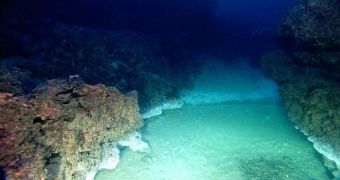Researchers discovered that the oceans hide a small number of brine-water lakes and rivers on their floor, especially in the Gulf of Mexico region. These in turn house their own variety of life, adapted to and relying on their saline features.
Thinking of what lurks beneath the ocean waves, very few people, if any, would picture something other than dark holes filled with nightmarish creatures like enormous squids or bioluminescent shellfish. No one would expect to find, say, lakes or rivers there. Yet, way deep under the waters, lying on the ocean floor, there is a cold and silent distinct world based on high salt levels.
Surprising as it may seem, these brine pools boast their own ecosystems. In fact, although oceans are called the briny blue, it is these lakes that are made up from real brine, because in spite of the fact that they consist of salt waters, oceans are not brine. Brine is a kind of water that contains enormously high salt concentrations, which makes it heavier than regular water and causes it to lie at the bottom of the sea.
Brine pools are generated by salt tectonic movements. During the Jurassic period, the seas of the Mexican Gulf were shallow and soon dried out, leaving behind an 8 km-thick layer of salt. Later on, when waters covered the respective area again, the mega-saline layer was covered with sediments and preserved, becoming an underwater lake.
Their huge levels of salt prevent the existence of most life forms. Still, a few extremophiles like bacteria, some shrimp or mollusks have found a way to live off the methane that is abundant in the area. They get their energy from the process of methane chemosynthesis, which the bacteria handle, and they pass on the energy through their symbiosis with the nearby mussels and other life forms. This makes the entire ecosystem rely solely on chemical energy, unlike the other ecosystems on Earth, which depend on the energy provided by the Sun.

 14 DAY TRIAL //
14 DAY TRIAL //